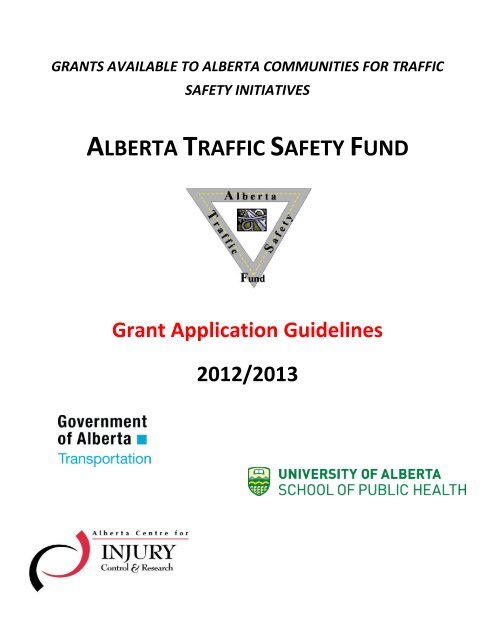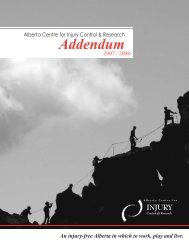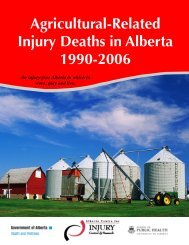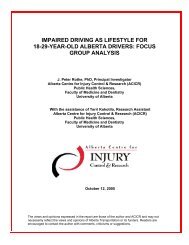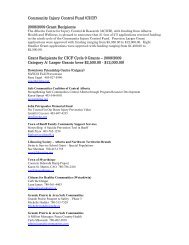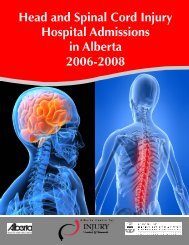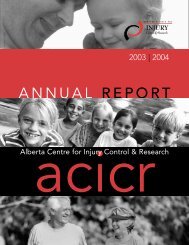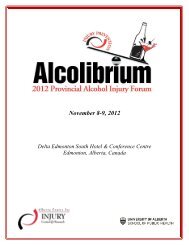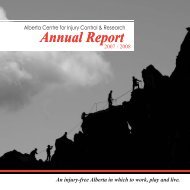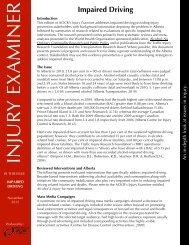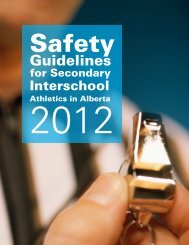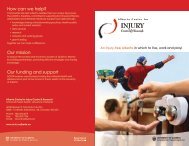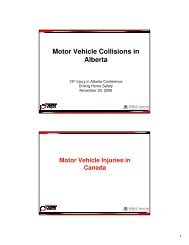grants available to alberta communities for traffic safety initiatives
grants available to alberta communities for traffic safety initiatives
grants available to alberta communities for traffic safety initiatives
You also want an ePaper? Increase the reach of your titles
YUMPU automatically turns print PDFs into web optimized ePapers that Google loves.
GRANTS AVAILABLE TO ALBERTA COMMUNITIES FOR TRAFFIC<br />
SAFETY INITIATIVES<br />
ALBERTA TRAFFIC SAFETY FUND<br />
Grant Application Guidelines<br />
2012/2013
INTRODUCTION<br />
APPLICATION GUIDELINES<br />
The Alberta Traffic Safety Fund (ATSF) evolved from the work of the Alberta Traffic Safety Foundation that was first<br />
incorporated under the Alberta Societies Act as a not-<strong>for</strong>-profit organization on November 1, 1994 and was<br />
dissolved by a motion of the Board in June 2006.<br />
The Alberta Traffic Safety Fund is a collaboration involving Alberta Transportation – Office of Traffic Safety and the<br />
Alberta Centre <strong>for</strong> Injury Control & Research. The introduction of the Alberta Traffic Safety Plan (ATSP) in<br />
November 2006 provides new opportunities <strong>for</strong> <strong>communities</strong> <strong>to</strong> be involved in local <strong>traffic</strong> <strong>safety</strong> <strong>initiatives</strong> through<br />
supportive strategies outlined in the Plan. The ATSF is a supportive strategy of the Alberta Traffic Safety Plan.<br />
GOAL<br />
The goal of the Alberta Traffic Safety Fund (ATSF) is <strong>to</strong> improve the quality of life in Alberta through community<br />
based, preventative, collaborative and focused <strong>traffic</strong> <strong>safety</strong> <strong>initiatives</strong> that support the strategic direction of the<br />
Alberta Traffic Safety Plan.<br />
PURPOSE<br />
The purpose of the fund is <strong>to</strong> encourage community groups and organizations <strong>to</strong> develop and implement innovative<br />
<strong>traffic</strong> <strong>safety</strong> projects that are consistent with the objectives of the Alberta Traffic Safety Plan. The ATSF specifically<br />
focuses on supporting small community <strong>traffic</strong> <strong>safety</strong> and <strong>traffic</strong> injury prevention projects where they work best - at<br />
the community level. The ATSF aims <strong>to</strong> encourage the building of community capacity through the nature and<br />
scope, of the projects that are funded.<br />
WHO CAN APPLY<br />
<br />
<br />
<br />
Non profit societies, associations, groups, and registered charitable organizations<br />
Community-based coalitions and networks (e.g. First Nations’ councils, Safe Communities coalitions, etc.)<br />
Publicly funded organizations or institutions excluding those already directly funded by Alberta<br />
Transportation (e.g. Schools, Family and Community Support Services, Police Services)<br />
GRANT APPLICATION APPROVAL CRITERIA<br />
Grants will be provided <strong>for</strong> specific <strong>traffic</strong> <strong>safety</strong> projects that are consistent with the overall purpose of the ATSF<br />
and the Alberta Traffic Safety Plan.<br />
Proposals should reflect clearly defined anticipated results that relate <strong>to</strong> local <strong>traffic</strong> <strong>safety</strong> problems and support<br />
provincial targets as outlined in the Alberta Traffic Safety Plan.<br />
GRANT APPLICATIONS WILL BE ASSESSED ON SUCH CRITERIA AS THE FOLLOWING:<br />
<br />
<br />
<br />
<br />
<br />
<br />
<br />
Community Concern or Need – The proposal clearly identifies and presents evidence of a significant <strong>traffic</strong><br />
<strong>safety</strong> need in the community.<br />
Alignment with the Alberta Traffic Safety Plan – Preferably grant applications will link <strong>to</strong> a specific<br />
strategic action identified in the Alberta Traffic Safety Plan and/or are consistent with provincial ATSP public<br />
awareness <strong>initiatives</strong>.<br />
Based on Evidence – The project presents credible evidence of the community <strong>traffic</strong> <strong>safety</strong> problem<br />
addressed, that the strategy <strong>to</strong> address the problem will be effective; and of community support.<br />
Innovation – If applicable, the project should present an innovative approach <strong>to</strong> <strong>traffic</strong> <strong>safety</strong> needs.<br />
Projects may also replicate successful projects if there is appropriate evidence of previous success.<br />
Builds on Existing Structures – The project promotes networking, partnership, and coordination.<br />
Financial Support – The proposal demonstrates the Proposing Organization’s ability <strong>to</strong> share costs <strong>for</strong> the<br />
project and/or provide resources (e.g. volunteers, equipment, donations, in kind contributions, and<br />
corporate sponsorship).<br />
Evaluation – The grant application will include specific measurable results expected, with an evaluation<br />
component (WHAT WE LEARNED) built in<strong>to</strong> the program.<br />
2
TYPES OF ELIGIBLE PROJECTS INCLUDE:<br />
1. Developing and implementing <strong>traffic</strong> <strong>safety</strong> strategies.<br />
Types of strategies/activities:<br />
a. Educational (e.g. public awareness campaigns or materials that support local or provincial <strong>initiatives</strong>,<br />
school programs, training workshops)<br />
b. Technological (e.g. raising awareness and promoting the use of new technological devices; guidelines <strong>for</strong><br />
the use of new devices; public awareness and education through review, analysis, and reporting of new<br />
devices; <strong>initiatives</strong> <strong>to</strong> reduce or remove the threat of injury in community environments)<br />
c. Legislative (e.g. preparation of briefing packages <strong>for</strong> awareness and education that might include<br />
economic, en<strong>for</strong>cement and <strong>traffic</strong> <strong>safety</strong> implications of legislation, policies, laws or regulations)<br />
2. Building or strengthening local involvement in community <strong>traffic</strong> <strong>safety</strong> coalitions, action groups,<br />
alliances, or networks.<br />
Types of strategies/activities:<br />
Community presentations, coalition member recruitment activities and orientation sessions, organizational<br />
meetings, planning sessions, <strong>for</strong>ums, communication <strong>to</strong>ols, promotional materials.<br />
3. Developing or strengthening local in<strong>for</strong>mation systems that support <strong>traffic</strong> <strong>safety</strong> ef<strong>for</strong>ts.<br />
Types of strategies/activities:<br />
Systems <strong>for</strong> collecting, analyzing and sharing local <strong>traffic</strong> <strong>safety</strong>/injury data, systems <strong>for</strong> coordinating and<br />
sharing <strong>traffic</strong> <strong>safety</strong> program in<strong>for</strong>mation, needs assessments, community injury profiles, focus groups.<br />
LIMITS TO FUNDING<br />
Grants are not <strong>to</strong> be used <strong>for</strong> the following:<br />
<br />
<br />
<br />
<br />
<br />
<br />
<br />
<br />
<br />
<br />
<strong>to</strong> construct or renovate facilities<br />
<strong>to</strong> repair or replace equipment<br />
<strong>to</strong> offset specific ongoing operational and administrative costs, e.g. rent, salaries, utilities (An administrative<br />
surcharge of 10% of the grant amount requested is allowable.)<br />
<strong>to</strong> undertake business ventures<br />
<strong>to</strong> support projects that are already underway, or have already taken place, or <strong>to</strong> duplicate programs already<br />
in place<br />
<strong>to</strong> cover a deficit budget<br />
<strong>to</strong> provide professional development <strong>for</strong> salaried employees<br />
hosting or hospitality<br />
research projects (Research that is a component of a larger <strong>traffic</strong> <strong>safety</strong> initiative may be considered)<br />
capital equipment (Note: Capital equipment purchases will be considered only if integral <strong>to</strong> the project and if<br />
renting or in-kind donations are not feasible or reasonable options. Please check with the Grant Program<br />
Coordina<strong>to</strong>r.)<br />
3
MAXIMUM GRANTS AVAILABLE<br />
The ATSF larger grant maximum is $17,000. Note: Support from community and other funding sources (in kind or<br />
financial) are expected and should be reflected in the budget. If approved, <strong>grants</strong> must be used only <strong>for</strong> the<br />
purposes described in the grant application.<br />
A grant of up <strong>to</strong> $5,000 is <strong>available</strong> <strong>for</strong> smaller <strong>traffic</strong> <strong>safety</strong> projects or <strong>for</strong> specific components of larger projects.<br />
Projects must be completed within a year of receiving funding. Applications <strong>for</strong> smaller <strong>grants</strong> will be accepted and<br />
reviewed on an ongoing first-come, first-served basis.<br />
LARGER GRANT APPLICATION DEADLINES<br />
SUBMISSION DEADLINES are: June 15, Oc<strong>to</strong>ber 15 and February 15.<br />
Smaller grant applications <strong>for</strong> under $5,000 may be submitted at any time.<br />
Applicants are required <strong>to</strong> contact the Grant Program Coordina<strong>to</strong>r prior <strong>to</strong> applying <strong>for</strong> either grant <strong>to</strong> discuss eligibility<br />
and <strong>to</strong> determine if project ideas con<strong>for</strong>m <strong>to</strong> fund guidelines. For projects over $5,000 you need <strong>to</strong> consult with the<br />
Grant Program Coordina<strong>to</strong>r at least two weeks be<strong>for</strong>e submission in order <strong>to</strong> receive a consultation number that you<br />
will enter on the application <strong>for</strong>m. Early consultation is advised.<br />
Please contact the Alberta Traffic Safety Fund Grant Program Coordina<strong>to</strong>r, Mandy Fisher @ (780) 492-0887 or<br />
e-mail: mandy.fisher@u<strong>alberta</strong>.ca <strong>for</strong> a consultation and <strong>to</strong> obtain the current grant application <strong>for</strong>m and<br />
guidelines.<br />
CONSULTATION DEADLINES <strong>for</strong> <strong>grants</strong> over $5,000 are: June 1, Oc<strong>to</strong>ber 1 and February 1 respectively.<br />
REGIONAL TRAFFIC SAFETY CONSULTANTS<br />
Currently there are 14 Regional Traffic Safety Consultants (RTSC’s) in Alberta who are supporting the Community<br />
Mobilization Strategy of the Alberta Traffic Safety Plan. The RTSC’s are key stakeholders in <strong>traffic</strong> <strong>safety</strong>. Once<br />
eligibility <strong>for</strong> an ATSF grant is confirmed, applicants are expected <strong>to</strong> advise their Regional Traffic Safety Consultant<br />
about the planned project.<br />
Larger ATSF projects are required <strong>to</strong> extend an invitation <strong>to</strong> the Regional Traffic Safety Consultant <strong>to</strong> be involved in<br />
the project as a collabora<strong>to</strong>r or adviser. This must be done as early as possible in the planning process.<br />
Applicants should confirm contact with the Regional Traffic Safety Consultant has been made on the application<br />
<strong>for</strong>m.<br />
To assist applicants with this process, the Grant Program Coordina<strong>to</strong>r will provide the name and address of the<br />
applicant’s Regional Traffic Safety Consultant.<br />
PARTNERSHIP LOGO<br />
Successful applicants may request permission <strong>to</strong> use the Alberta Traffic Safety Fund logo <strong>for</strong> promotional materials.<br />
4


